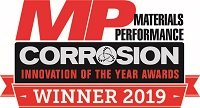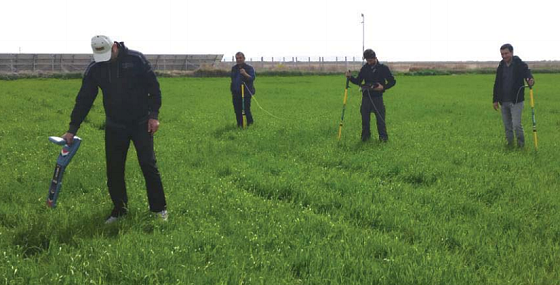A new Hexcorder Pro instrument from Cathodic Technology Ltd. (Caledon, Ontario, Canada) is designed to measure and record both close interval potential survey (CIPS) and direct current voltage gradient (DCVG) pipeline data from the field with corresponding GPS coordinates.
The cathodic protection (CP) surveying instrument, which is now commercially available, is aimed at improving the effectiveness of surveys in congested or difficult areas and also at better displaying and managing the data, according to Pat Yaremko, sales and marketing manager. “This was purpose built by corrosion engineers for corrosion engineers, specifically designed to do nothing but pipeline integrity surveys,” he says of the product.
The instrument was one of 10 winners selected by a panel of corrosion industry experts for the 2019 MP Corrosion Innovation of the Year Awards, honored in March 2019 in Nashville, Tennessee, USA. Further technical details and case histories are available at the awards web site.
Overcoming Prior Limitations
 According to the company, prior surveying instruments offered only limited real-time information. “Surveyors often had to juggle many instruments and attempt to integrate different data streams, post-survey,” Yaremko explains.
According to the company, prior surveying instruments offered only limited real-time information. “Surveyors often had to juggle many instruments and attempt to integrate different data streams, post-survey,” Yaremko explains.
Historically, CIPS and DCVG survey equipment has consisted of a single channel. However, the company’s innovation includes four DCVG channels to allow for simultaneous gradient recording of any combination on the left, right, front, and rear of a pipeline. “For example, when performing a DCVG survey on parallel pipelines, the gradient must be obtained to both the left and the right side of the pipe to confirm which pipe has the defect,” Yaremko says.
The DCVG can be displayed as on/off readings, or as the calculated gradient. Another data screen on the device incorporates data from analog-style DCVG gauges, which contain high/low needles to represent the pulsing of the CP current. In fast surveying cycles, the user can detect defects as the gap between needles grows larger.
The product, which has 10 different survey modes in total, can further record CIPS measurements at two different input impedances, 25 MΩ and 250 MΩ, in a single pass. “In dry and difficult conditions, this allows the analyst to calculate the true polarized potential to provide a more accurate assessment of the cathodic protection,” Yaremko explains. In difficult locations, the device is capable of performing double impedance surveys.
Survey modes include DCVG only, CIPS only, combined DCVG and CIPS, multi-person DCVG mode, and more. According to the company, these types of improved features offer advantages to field surveyors, analysts, and pipeline owners. Benefits include more reliable data and the ability to better adapt surveys to changing conditions.
The device consists of a black box of specialized circuitry connected to a rugged, 10-in (25.4-cm) Android tablet via Bluetooth, and it records chainage, date, time, altitude, and GPS location data with each reading. A street map of the survey area is cached to the tablet memory for field use. Thus, no internet connection is required during survey hours, and surveyors can see their real-time positioning. Meanwhile, the Bluetooth functionality allows for the integration of pipe locator depth of cover information without needing manual data entry.
Design Upgrades
Along with improving the quality of the data, the product’s developers also wanted to boost the display and management of the data acquired. “One of the challenges in the field has always been visualizing the data in real time,” Yaremko says. “Prior technology displays were limited and often small.”

With the new device, users can choose to view any two of five survey data screens at a time. The five screens include a numerical table displaying CIPS and DCVG values; a graph mode with each channel independently displayed; a "bird's-eye view” with an aerial representation; a street map of the survey area; and analog DCVG gauges.
“At any time, the operator can change the screen choice on the fly without having to start a
new file,” Yaremko says. “Improving the user’s ability to interpret the data in the field also improves their ability to record accurate data, reducing the amount of post-processing later.”
No special software is required to use the instrument or view the data, since the device utilizes standard Microsoft programs and an Android app. All data is displayed on the corresponding free “Cath-Tech” app, available for Android on Google Play store.
Successful Field Testing
Prototype units were first field tested in 2015 at a ski hill in Ontario, Canada, using their impressed current cathodic protection (ICCP) for the snow-making lines in the summer months. Initial tests were conducted with the new device and older models to allow for data comparison.
Findings from the 2015 ICCP system testing resulted in a physical redesign of the device, with changes to the box and connectors. From there, the device was sent out for further testing in 2017 in Poland, China, and Alberta, Canada.
“Connectors were still an issue,” Yaremko says of the second round of testing. “The cables must be connected and disconnected multiple times in the field, so the connectors must be watertight and easy to use with gloves on.” The company found that threaded connectors were too difficult and prone to damage from mud, so they switched to a metal push/pull waterproof connector.
After a final round of successful field testing in the summer of 2017, the enhanced device was handed off to production and is now commercially available. According to the company, units are currently in the field in Canada, the United States, Brazil, Nigeria, China, Kazakhstan, India, Argentina, and Turkey.
The company also developed a demo version of the app, called “Cath-Tech Hexcorder Demo,” for the Google Play store. The free app allows end users to view preloaded data on a continuous loop. “They can change survey setup parameters, interruption cycles, and display settings to see what is now available,” Yaremko says of the demo.
Further information on the system is available at the company’s web site.
Source: Cathodic Technology Ltd., www.cath-tech.com. Contact Pat Yaremko—e-mail: pat@cath-tech.com.